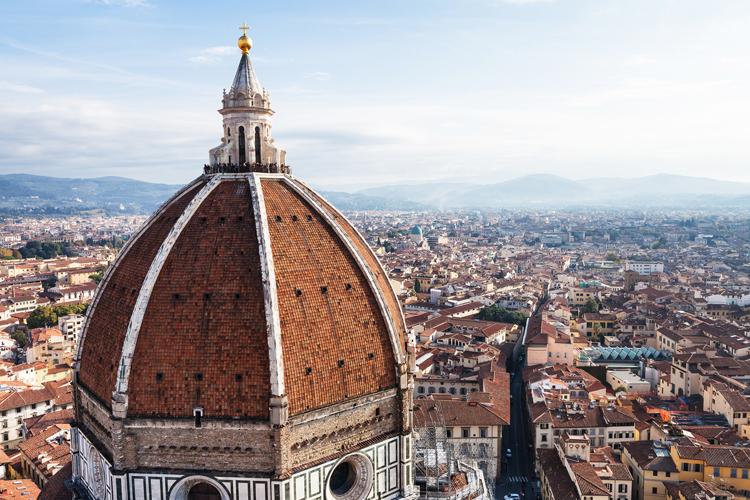Brunelleschi’s Dome: The Greatest Work of Architecture
ITA:

Use player to listen to Italian version
In 1418, the Opera di Santa Maria del Fiore in Florence announced a competition for the design of the dome of the city’s cathedral, whose construction had begun in 1296. Filippo Brunelleschi and Lorenzo Ghiberti, long-time rivals, were hired for the work, although, in 1425, five years after the opening of the construction site, Ghiberti quit and Brunelleschi became the sole supervisor.
Brunelleschi is considered the first great architect of the Renaissance: he broke with previous architectural models and was able to transpose the laws of proportion and perspective, pillars of Renaissance art, into a magnificent masterpiece. The cupola of Santa Maria del Fiore is such an outstanding work of architecture that people are still puzzled today as to how he was able to achieve such a feat.
To decrease the excess thrust, Brunelleschi devised a cover made of two shells connected by a complicated network of arches and buttresses. He even came up with machines that were able to lift enormous blocks of stone weighing up to three tons from the ground to the right heights (machines that were unparalleled until the Industrial Revolution). Just imagine what kind of amazing sight the construction yard must have been for the Florentines of the time!
Brunelleschi built a wooden model of the dome which would serve as a guide for his assistants; it is on view in the Museo dell'Opera del Duomo.
Today, it is possible to climb up to the cupola; you have to walk 463 steps, but the experience is worth the effort! The walk takes you through the interior of the dome, with an amazing view over the nave, and gives you a closer look at the beautiful frescoes by Giorgio Vasari. From the stairs leading to the top, you have a fascinating view over the structure of the dome. And once you reach the top, the view of Florence is just great.
Nel 1418, l'Opera di Santa Maria del Fiore a Firenze annunciò un concorso per la progettazione della cupola della cattedrale, la cui costruzione era iniziata nel 1296. Filippo Brunelleschi e Lorenzo Ghiberti, rivali di lunga data, furono scelti per il lavoro, anche se, nel 1425, cinque anni dopo l'apertura del cantiere, Ghiberti abbandonò il progetto e Brunelleschi divenne l'unico capomastro.
Brunelleschi è considerato il primo grande architetto del Rinascimento: allontanandosi dai modelli architettonici precedenti, fu in grado di tradurre le leggi della proporzione e della prospettiva, pilastri dell'arte rinascimentale, in un magnifico capolavoro. La cupola di Santa Maria del Fiore è un’opera così eccezionale che ancora oggi ci si chiede come l’artista fiorentino sia stato in grado di realizzare una simile impresa.
Per diminuire l’eccesso di spinta, Brunelleschi ideò una copertura costituita da due calotte collegate tra loro da una complessa rete di archi e contrafforti. Ideò anche delle macchine capaci di sollevare alla giusta altezza enormi blocchi di pietra che arrivavano a pesare fino a tre tonnellate (macchine che non sono state eguagliate sino alla Rivoluzione Industriale). Provate a immaginare che spettacolo incredibile doveva rappresentare il cantiere per i fiorentini di allora!
Brunelleschi costruì un modello ligneo della cupola, che doveva servire da guida per i suoi assistenti; oggi è in mostra nel Museo dell'Opera del Duomo.
Per salire alla cupola, bisogna ‘scalare’ 463 gradini, ma ne vale la pena! La camminata conduce all'interno della cupola, regala una splendida vista sulla navata, e sui bellissimi affreschi di Giorgio Vasari, che possono essere ammirati da vicino. Dalla scala che porta in cima, si ha una vista affascinante sulla struttura della cupola. E una volta raggiunta la cima, la visione panoramica su Firenze è semplicemente fantastica.











